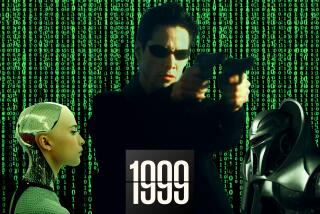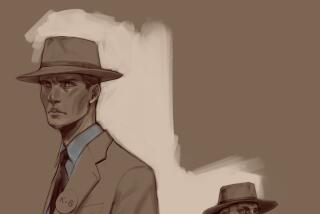Review: Charlize Theron is toughness incarnate in the stylish, self-regarding ‘Atomic Blonde’
About halfway through “Atomic Blonde,” Lorraine Broughton (Charlize Theron), a lethal MI6 superwoman on assignment in Cold War-era Berlin, goes to see Andrei Tarkovsky’s “Stalker.” OK, not really. Her latest intrigue leads her to an Alexanderplatz theater showing that 1979 Soviet slow-cinema masterwork, setting the stage for an ultra-cool fight scene in which she kicks, punches and even face-stabs her opponent, all while silhouetted against Tarkovsky’s famously somber, unblinking images.
There are all sorts of ways to interpret this bold juxtaposition, which can be defended as homage, attacked as desecration or (most accurately) diagnosed as evidence of this movie’s hopeless infatuation with its own fabulous retro style. Obsessive “Stalker” fans might offer up a more literal-minded reading: Charlize Theron is, like, totally in the Zone!
They’ll get no argument from me. It’s been thrilling to see Theron ascend to the very top ranks of Hollywood action stars, her position confirmed by her magnificent turn as Imperator Furiosa in “Mad Max: Fury Road,” and not too badly threatened by her recent appearance in “The Fate of the Furious” or my distant memories of “Aeon Flux.” In “Atomic Blonde,” the actress has become an avatar of icy, murderous impassivity. To see her attacking thugs with kitchen appliances or submerging her battered body in a frigid bath is to be happily reminded that sometimes the movies get it right — even when the movie itself, in this case, seems largely beside the point.
Maybe that’s not entirely fair. Adapted by Kurt Johnstad from Antony Johnston’s and Sam Hart’s graphic-novel series “The Coldest City,” “Atomic Blonde” may be a delirious exercise in outré nonsense, but it can also be a brutally effective action picture when the inspiration strikes. Its director is David Leitch, a longtime stuntman and second unit whiz who served as an uncredited co-director on the terrific “John Wick.”
Leitch’s chops are amply confirmed by the stunningly attenuated action sequence that serves as the new movie’s raison d’être. For nearly eight minutes, Lorraine takes out a gang of KGB thugs (occasionally one will let out a vaguely Russian-accented “oof!”) while covering what appears to be every square inch of an apartment building, demolishing furniture and laying waste to a perfectly lovely stairwell in the process.
It’s a legitimately jaw-dropping scene, shot (by “John Wick” cinematographer Jonathan Sela) and digitally tweaked to look as though it were achieved in a single unbroken take, in the look-Ma-no-edits style popularized by movies like “Children of Men” and “The Revenant.” As gimmicks go, it’s a hugely enjoyable one. Leitch is a master at delineating visual space and a scrupulous observer of the laws of physics, and the absence of obvious cutting makes it all the easier to appreciate the brutal realism and steadily mounting crescendo of the violence.
Speaking of physics: If every action must yield an equal and opposite reaction, that might explain how, in contrast with the hyper-clarity of its shooting and staging, the plot of “Atomic Blonde” should be such a murky, nonsensical blur. I’ll try to keep the exposition brief, even if the movie, at 115 minutes, does not. Late in 1989, mere days before the fall of the Berlin Wall, a looming intelligence crisis sends the steely, hyper-efficient Lorraine into the fray, determined to track down a stolen list of CIA and MI6 agents. (You can safely assume that every agent on the list is named MacGuffin.)
Lorraine forms an uneasy alliance with David Percival (James McAvoy), the scuzzy chief of MI6’s Berlin bureau, who has become embroiled in dubious black-market dealings and is clearly not to be trusted. She also makes contact with Spyglass (the always excellent Eddie Marsan), a ratty Stasi defector who’s anxious to flee Berlin, and Delphine LaSalle (Sofia Boutella), a sultry French spy who tickles her fancy. Their couplings aren’t filmed with much tenderness or heat, but by that point you’re grateful for any physical contact that doesn’t end with a frying pan to the face.
[Lorraine] seems visually modeled on the singer Debbie Harry — an influence that weighs more heavily than anything so piddling as personality or back story.
With David Hasselhoff in town and “Tear down this wall” blaring from every TV, Berlin is clearly facing a tense geopolitical moment, as we’re reminded by an overly knotty framing device that finds Lorraine narrating most of the story in flashback for an MI6 superior (Toby Jones) and a CIA operative (John Goodman). But “Atomic Blonde” ultimately regards Cold War history with scarcely more interest than it regards Theron’s last costume change, and the movie’s fascination with the period seems to extend no further than its highly exploitable ’80s aesthetics.
There’s nothing especially wrong with that. It’s far from unpleasant to watch Lorraine choreograph her martial-arts moves to George Michael’s “Father Figure,” or brood up a storm while listening to a moody electropop cover of “99 Luftballons.” (Also on the soundtrack: Depeche Mode, New Order and the theme from “Tetris.”) In one scene Lorraine orders a Stoli on the rocks — well, in many scenes, but bear with me — in a bar drenched in so much red lighting, you wonder if she’s stumbled into an outtake from “The Neon Demon.”
Theron’s magnetism has many layers, even when it’s not in service of a particularly interesting character. Given the title’s in-jokey reference to Blondie’s “Atomic,” it’s likely no coincidence that Lorraine, with her platinum hair and black thigh-high boots, seems visually modeled on the singer Debbie Harry — an influence that weighs more heavily on the character than anything so piddling as personality or back story.
And so what? Personality and back story are for wusses. Or for men. Or for James Bond. Lorraine Broughton welcomes your box-office dollars, but the last thing she requires is your sympathy, or your engagement, or any response more complex than a simple appreciation for the beautiful, inscrutable, narrative-defiant object that she is. Maybe she does belong in a Tarkovsky movie after all.
------------
‘Atomic Blonde’
Rating: R, for sequences of strong violence, language throughout and some sexuality/nudity
Running time: 1 hour, 55 minutes
Playing: In general release
See the most-read stories in Entertainment this hour »
Movie Trailers
ALSO
Review: ‘Brigsby Bear’ is a charming, affectionate tribute to the joys of amateur filmmaking
Review: Tiffany Haddish is a comic revelation in the sweet, sexy and hilarious ‘Girls Trip’
More to Read
Only good movies
Get the Indie Focus newsletter, Mark Olsen's weekly guide to the world of cinema.
You may occasionally receive promotional content from the Los Angeles Times.







